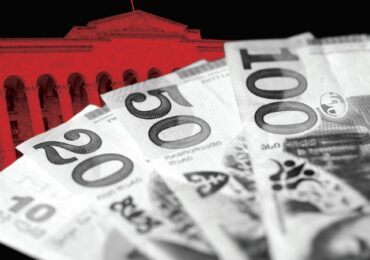Crises affect all economies from time to time. Thus we can be sure that sooner or later, a financial crisis will be heading our way; leaving behind an era of cheap money. The world is approaching a crucial time, and events such as the dramatic increase in the levels of internal and external bad debt, trade wars and high interest rates set by central banks can all be viewed as possible signs of another global economic crisis not being far away. Assessing a global financial crisis naturally requires a comprehensive approach that is not focused on just one factor. Based on the latest information from the World Bank, the volume of trade and the rate of production are both in decline. Global manufacturing grew by 3% year on year between 2010 and 2018, with the equivalent figures for the period between 2000 and 2008 being 7%. The current low level of growth was only ever recorded during the 2008-2009 crisis.
Over the last ten years the volume of debt has grown across the world. The United States, the Eurozone, China, Japan and the United Kingdom do not have tools to deal with the problem of debt. In 2008, centrals bank could help the economy by printing money and purchasing bank assets. This is no longer possible today. Central banks have already purchased a lot, and any further quantitative easing would jeopardize the economy and the financial markets. China, which currently accounts for 17% of global GDP, 28% of global manufacturing and 45% of global growth, is the largest contributor to the fall of nominal GDP and revenues. Chinese debt could become the catalyst for problems, potentially causing a similar shock to the one witnessed in the United States in 2008, or in the developing countries during the 1990s. The Chinese state policy is aimed at reducing the risk of financial shocks. In this regard, we must bear in mind that Chinese external debt is financed through the domestic market, and that China remains a global net creditor. Nevertheless, it is highly likely that the crisis will start in China. This is because since 2008, Asian banks and companies have been accumulating debt at a faster rate than western financial organizations; most of this is bad debt. The situation has become more and more difficult for Asian banks, as well as those from other developing countries, as the Federal Reserve of the United States has gradually put up interest rates on U.S. bonds. Consequently, as U.S. bonds begin to yield more, investors have been withdrawing funds from the risky Asian market. The Asian financial crisis of 1997 was triggered by similar circumstances.
Signs of an upcoming recession also include reduced economic activity in ‘Asian Tiger’(the high-growth economies of Hong Kong, Singapore, South Korea, Taiwan and Japan) countries, the United States, United Kingdom, Germany and other European Union member states. More specifically, exports in China fell by 30%, 12% in the United States, 14% in the European Union and 21% in Japan. South Korean exports also fell significantly. This is the sharpest decrease of its kind over the last ten years and is due to a dramatic reduction in demand for the countries’ main industrial exports (namely cars and semi-conductors). This in turn reduces the volume of production and supply of the products in question. At the same time, reduced demand also reflects the economic activity in the consumer countries. Central banks in these countries are reducing refinancing rates in an effort to cheapen their currencies and encourage manufacturing, with the exception of the U.S. Federal Reserve, which is actually raising rates. Germany faces the danger of a recession, as external economic risks such as Brexit and the U.S.- China trade war have created a depression within the economy. OECD (Organisation for Economic Co-operation and Development) has reduced Germany’s GDP growth forecast from 1.6% to 0.7%. The forecast for the following year is 1.1%. Germany’s export-oriented economy has been damaged by higher trade barriers and reduced global demand.
The United States Federal Reserve has raised interest rates for the third time in 2019, indicating that it will do so once again by the end of the year. The monetary committee raised the discount rate by 0.25%, and the figure is currently fluctuating between 2% and 2.25%. This is the eighth time interest rates have been increased since 2015, when the Fed adopted a stricter monetary policy. Nevertheless, the protectionist trade policies recently implemented by the United States may damage both American and global economies. We can expect interest rates to be raised even more frequently in 2020, which will increase the cost of loans and reduce economic activity. The U.S. economy is overheating, and inflation levels are above target figures. Consequently, the Fed will continue raising the refinancing rates to 3.5%, strengthening the exchange rate of the dollar both within the United States and against the currencies in those currencies where the level of dollarization is high, and the exchange rate is floating. Inflation growth may also be stimulated by rising oil prices in developed countries (Germany, United States, China, United Kingdom and the European Union), meaning that other central banks will follow the Fed’s example and raise interest rates.
The United States’ trade relations with China, Mexico and the European Union are becoming increasingly protectionist in nature, which is bound to increase inflation, reduce the volume of international trade and hinder global economic growth. At the same time, increased domestic investment in the United States is likely to reduce foreign investment and limit the export of technologies, which will break the production chain. American protectionism will force China to reduce economic growth based on excessive manufacturing forces, while the developing markets will feel the effects of protectionism. Stricter monetary policies and slower economic growth in the United States will also damage the European Union. Moreover, external debts in countries such as Italy, Spain and Greece are likely to increase on the back of populism, further straining relations between debtor states and their main creditors – German and British banks.
It is expected that the profit and price coefficient in the United States will be 50% above the average figure, and state bonds will become very expensive due to their low profitability. High-yielding loans will also become expensive, and U.S. corporate credit will reach its all-time highest level. Furthermore, real estate prices will increase both within the United States and across the rest of the world. Liquidity risks on the financial markets will increase parallel to the aforementioned processes. Brokers are likely to reduce their activity, while developing countries will lose access to Federal Reserve loans.
There will be a widespread lack of resources to deal with the effects of a recession. There is limited space for fiscal stimulus due to the large volume of state debt, while non-traditional monetary and loan policies are made difficult by inflated balances.
It is important to analyze the profitability of U.S. treasury securities. This is because inverted profitability of U.S. state securities is seen as one of the signs of an approaching crisis. Inversion describes a situation where two-year securities are more profitable than ten-year securities. It reflects the investor’s hope that interest rates will increase only in the short term, rather than in the longer term. Such a situation has not yet arisen, but is highly likely to materialize within the next 12 months, as normalization of interest rates means that the Fed will increase the rates to 3.5%. This figure is likely to rise in four stages of 0.25 percentage points soon. This is most likely to affect the growth dynamics of profitability of short-term treasury securities.
According to economic theory, there are medium-term (ten-year) cycles that are based on periodic changes in economic activity. The cycles themselves include four stages: expansion, peak, recession (reduction of economic activity) and depression (i.e. a financial crisis).
Donald Trump’s policies are currently aimed at stimulating the economy through tax cuts, repatriating capital, creating jobs and industrial forces, and ultimately growing the economy by lowering the unemployment rate and encouraging economic growth. At this stage, money usually becomes more expensive and investment levels drop. Excessive forces and excessive production of goods leads to the onset of the recession phase, which is characterized by lower production, reduced profits and job cuts. Production levels drop to the minimum, while unemployment levels increase. Labor becomes cheaper and salaries are cut, thereby encouraging new investment. The cycle then repeats itself continuously.
The monetary authorities are trying to mitigate the negative effects of the economic cycle through counter-cyclical activities; such as regulating refinancing rates and cash supplies, as excessive supply always leads to a recession. In this case, the raising of the interest rates by the Federal Reserve can be seen as a sign of an incoming crisis.
The biggest global risk is not the possibility of a recession in the United States, but the extremely high level of bad debt that increased rapidly on the back of soft lending policies employed by central banks across the world. The total debt of developing countries alone has already exceeded $7 trillion, which is twice more than the level prior to the 2008 global crisis. The increase of the discount rate in the United States was accompanied by economic growth and the reduction of the Federal Reserve balance, which means that the banking system is supplying less money, while more and more offshore revenues of American corporations are being repatriated to the United States. Along with Trump’s aggressive economic policies, this will reduce the supply of dollars to the global economy and make it difficult for countries and corporations to refinance external debt. This will in turn reduce investment activity across the world.
We should also bear in mind that U.S. dollars are actively being used across the world to create reserves and conduct international payments. In order to ensure circulation of a large amount of dollars on international markets, Americans need to buy as many imported goods as possible, while the United States needs to have a negative trade balance, which it covers by issuing new dollars. This is precisely what the Trump administration is fighting against, its large-scale trade wars are aimed at reducing imports and increasing domestic production. Continued decline in international trade, the raising of interest rates by the Fed and a shortage of dollars in the global market may provoke another crisis; the epicenter of which will be not the United States but its main trading partners and debtor countries where the dollarization level is high. The crisis will then spread to other economies.
The current trade war between the United States and China has contributed towards the escalation of a global economic crisis by significantly reducing investors’ trust towards the Asian markets. Europe has already suffered from the slowdown in Chinese economic growth. China is the main buyer of German manufacturing goods (cars and equipment). Manufacturing goods form the core exports of the EU’s most developed countries. Resultantly, the German economy may already have entered a period of recession.
American companies are also being hurt by Trump’s trade wars, as the level of trust of investors towards the United States is fast decreasing. On the other hand, Trump’s economic tax stimulus programme is due to finish in 2020. Over the last two years, the U.S. economy has grown at a fast rate on the back of said programme, although economists believe that this process has been conducted artificially. The end of the programme will reduce the rate of economic growth, reducing investor trust both in the United States and in other countries. Based on this fact, many forecasts are predicting the global economic crisis to begin in late 2020 or in early 2021. It is also possible that the sharp rise in oil prices may hasten the crisis’ arrival.
Expectations play a big role. Ten years have passed since the last financial crisis, which corresponds to the cycle theory. The likelihood of a new crisis is, therefore, very high. A crisis is a normal occurrence. It can be viewed as an element of technological and other changes on the financial or labor market.
Consequently, another global economic crisis is inevitable. However, to mitigate its effects, it is vital to liberalize global trade as much as possible. More specifically, this implies the signing of the Trans-Pacific Partnership Agreement, a trade agreement between the United States and the European Union, as well as reducing obstacles to global trade.












